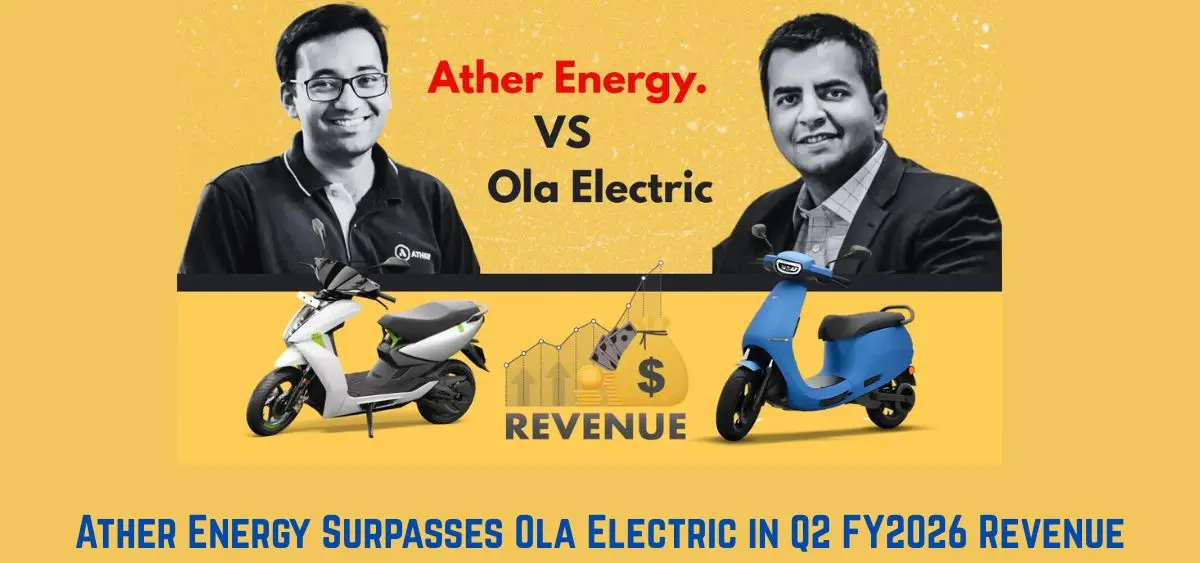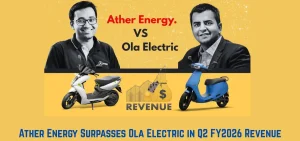Ather Energy Surpasses Ola Electric: a headline that’s turning heads across India’s booming EV sector. In a surprising twist, Ather has raced ahead of Ola in quarterly revenue for Q2 FY26, redefining the electric two-wheeler rivalry. What fueled this dramatic rise? From innovative scooters to smart business moves, Ather’s strategy is setting new industry benchmarks. Let’s dive into how this remarkable turnaround is reshaping the future of India’s electric mobility landscape.
Financial Highlights: Ather Takes the Lead
According to the latest financial data, Ather Energy posted a record revenue of ₹899 crore, a 54% year-on-year growth, making it the company’s highest-ever quarterly performance. The company also managed to narrow its net loss to ₹154 crore, compared to ₹197 crore in the same quarter last year, demonstrating strong financial discipline and operational efficiency.
On the other hand, Ola Electric reported revenue of ₹690 crore, marking a steep 43% decline year-on-year. While Ola succeeded in reducing its net loss from ₹495 crore to ₹418 crore, its falling revenue highlights the company’s struggle to sustain market momentum in an increasingly competitive segment.
Ather’s Winning Formula: Growth, Innovation, and Expansion
Ather’s remarkable performance in Q2 FY26 can be attributed to its surging sales and successful product diversification. The company recorded a 67% increase in vehicle deliveries, reaching 65,595 units during the quarter.
The key driver behind this surge has been the launch of Ather Rizta, a family-oriented scooter that has gained significant traction across new markets. The model’s blend of performance, practicality, and design has resonated strongly with Indian consumers, helping Ather expand its market share to 17.4% in the electric two-wheeler segment.
Moreover, Ather’s strategic focus on non-vehicle revenue streams — including software subscriptions and connectivity services — has contributed to margin expansion. Its adjusted gross margin rose to 22%, supported by cost optimization and value engineering initiatives.
Ola’s Struggles: Market Share Pressure and Declining Sales
Ola Electric, once the undisputed leader in India’s EV space, appears to be facing headwinds. Despite its aggressive pricing and product lineup, the company’s 43% revenue decline suggests challenges in sustaining demand and managing operational scale.
While Ola did achieve profitability in its auto segment on an EBITDA basis, a commendable milestone, the company’s overall consolidated losses remain higher than Ather’s. This contrast underlines the importance of sustainable growth and diversification over rapid expansion.
Path Toward Profitability: A Shift in Strategy
Both Ather and Ola are working toward profitability, but their paths differ.
- Ather Energy is leveraging improved operating leverage, margin expansion, and retail network growth to move closer to breakeven.
- Ola Electric is emphasizing cost control and operational efficiency, but faces challenges in maintaining growth amid rising competition and market saturation.

The Road Ahead: Ather in the Driver’s Seat
Ather Energy’s ascent marks more than just a quarterly win — it signals a strategic evolution in India’s EV industry. The company’s disciplined scaling, innovative product strategy, and diversification beyond vehicles have positioned it as a serious contender for long-term market leadership.
Meanwhile, Ola Electric’s next few quarters will be crucial as it works to reclaim lost ground and stabilize its business model.
As India’s electric mobility revolution accelerates, Ather’s rise over Ola Electric in Q2 FY26 may well define the next phase of competition — one focused not just on volume, but on sustainability, innovation, and profitability.
Related Articles:-





